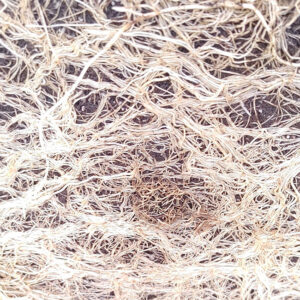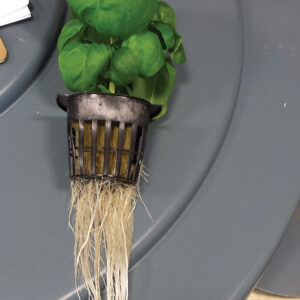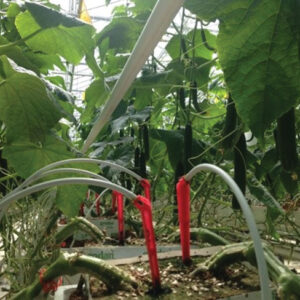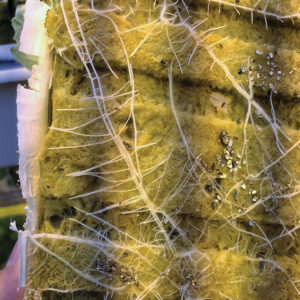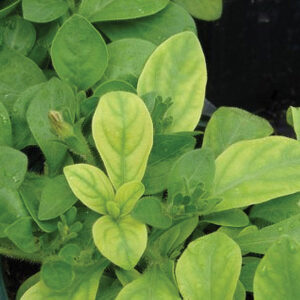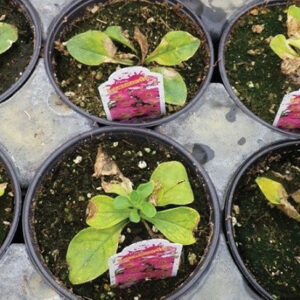
Features
View from the top to know what goes on below
Root zone health is vital for top performance of greenhouse crops so here is some guidance on monitoring the health of the roots from the ground up
March 18, 2024 By Mohyuddin Mirza
 Figure 1: Pea sprouts being germinated in trays without a growing medium. Strong matting occurs but these are very healthy, water absorbing roots and very healthy tops.
Figure 1: Pea sprouts being germinated in trays without a growing medium. Strong matting occurs but these are very healthy, water absorbing roots and very healthy tops. This article has its roots in two articles published in February 2013 and March-April 2016 issues of Greenhouse Canada. In the first issue I wrote about the complexity of root zone which depends on every input in the growing medium where roots live, grow and decay. The roots spend their lifetime in the ‘dark,’ although they love to come ‘outside the box’ in search of water and nutrients and still perform their functions.
Since it is inconvenient to look into the root zone, we can always look at the top of the plant to gauge how the roots are doing. For example, if plants are showing wilt symptoms, we know roots are not absorbing water because there was not enough water around the roots. Similarly, if there are nutrient deficiencies in the leaves, we know that roots are not taking up the nutrients due to pH or EC (electrical conductivity) stress.
A better understanding of root zone health status is being achieved today with the technology and sensors available to growers to interpret plant signals.
How to support a healthy root zone
1. Know every thing about the growing medium you are using
This is the starting point. Here are few points:
- The water holding capacity (WHC) and air porosity (AP) of each batch you use.
- What are the essential components of the growing medium and which one is involved with WHC and AP. Some components may degrade over a period of time and thus change the root zone health characteristics.
- Particle size if you are using media like coir, peat, rice hulls, sawdust and others.
- In water-based systems you must know the quality, especially be aware of sodium levels.
- Know how to properly drain the growing medium bags or containers. Slits in the grow bag should be made near the bottom of the bag so that excess water will not build up and damage roots. Slits should allow almost complete drainage. A large reservoir maintained in the bag reduces the volume of aerated root zone, which plants need to grow optimally.
- You must know the starting pH and EC of the growing medium. It has a major impact on root zone health.
2. Know your water quality
Water is the largest input which affects root zone health. The major points are:
- Overall quality is determined by pH, EC and SAR values (Sodium Absorption Ratio). SAR values are important from a root zone perspective because it reflects the time period in which the growing medium will become saline and affects water uptake.
- Sodium level below 50 mg/L are acceptable and would not impact root zone health negatively.
- Don’t forget about other elements which can become toxic to roots, like high fluoride and boron and zinc.
3. Carefully monitor the Dissolved Oxygen (DO) content
DO content is important for root health and every grower should know the DO content. If it is too low (below 4 ppm) then diffused oxygen technology should be employed. High O2 levels in the root zone reduce the need for expensive applications of pythium controlling fungicides. Low O2 levels affect ion uptake which happens at the root hair level which is stimulated by high O2 levels. Many DO technologies and systems are available in the market place. Choose a system where oxygen stays dissolved at higher water temperatures. In my experience the DO levels at drip line should be around 8 to 10 ppm at 18 to 20oC.
4. Irrigation and lighting
Your irrigation practices should be aligned with the sunlight or supplemental lights available. Timing of first drain is important, much more than the percentage of drain over the 24-hour period.
5. After oxygen, pH is probably the next most important element to monitor
pH constantly changes and fluctuates as the crop grows. Normally, as plants grow and fruit, the pH will start climbing, and move towards the alkaline side. If you don’t watch it daily, suddenly the pH will climb to over 6.8 and you will notice when there is iron deficiency in the new growth. Many growers will drop the feed pH to around 5.1 to 5.4. I believe this is very low pH for the roots and I have seen root tip damage quickly. A better approach is to monitor the pH daily, watch for the trend of going up or down and make adjustments before you have to intervene drastically.
6. Electrical Conductivity (EC)
For proper root zone health monitoring EC on a daily basis is as essential as pH. Its importance is highlighted in Figure 4 (on the previous page).
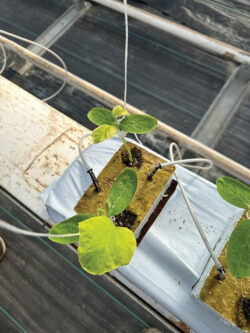
Figure 4: These young cucumber plants are showing signs of EC (electrical conductivity) stress.
The image was contained in an SOS message from a cucumber grower who noticed that the cotyledonary leaves were yellow and some green veins. The rockwool blocks were placed on coir bags and roots had not started going into the bags. I immediately asked to check the root zone EC and pH by squeezing solution out of these rockwool blocks. The squeeze EC came at 7.4 mS/cm2 and pH at 6.8. That showed that roots were under a big water stress and alkaline pH stress. It happens when growers start fertilizing young seedlings and water evaporates from the rockwool blocks which results in high values.
The grower was asked to stop fertilizing and leach with pH 5.5 water. After about one litre of water drip over four hours the EC value of squeeze came down to 3.0 and pH to 6.1. The leaves started showing green colour the next day.
7. Modern growing media and root zone management
Figures 5 and 6 show seedless cucumber and highlight the importance of irrigation inputs, root zone health and volumes.
The cucumbers are grown in plastic buckets with 11L of coir and there are four plants in each bucket. Thus, there are 2.75L of coir per plant. This means roots will be developing in areas where extra water drains out and outside of the growing medium. One can see how early roots are developing at the base of the block.
8. Consider bio control strategies
Mismanagement of the root zone and resulting diseases will directly affect a plant’s ability to absorb water and nutrients but the use of pesticide drenches at wrong rates or applied at wrong times may also cause damage. In this case, growers are urged to employ bio control strategies. Consider this aspect of root disease management for optimum root health.
Advice for bedding plant growers
With the bedding plants season upon us, I want to discuss briefly issues with root health in these crops.
Figure 7 is an example of where attention was not paid to pH in the root zone. These petunias are showing iron deficiency caused by alkaline pH in the root zone. It will take at least three weeks to turn this crop around and these plants may be un-saleable. Figure 8 shows how water-logged conditions prevailed and roots did not develop properly. Growers are advised to adjust practices to avoid water-logged situations.
From the ground up, the top growth of plants can tell us much about the health of roots. Learn to read the plants and make decisions accordingly.
5 key tips for a healthy root zone
- Get to know everything about your growing medium: water holding capacity, air porosity and starting pH and EC.
- Water quality is key: determined by pH, EC and SAR (sodium absorptions ratio); sodium levels below 50 mg/L are ideal.
- Monitor Dissolved Oxygen (DO) levels to reduce the need for expensive fungicide applications. Anything below 4 ppm too low!
- Keep daily tabs on pH levels and adjust accordingly to avoid having to intervene drastically later in the crop’s development.
- Electrical Conductivity (EC) should be monitored as regularly as pH and can help identify nutrient deficiencies before they become a bigger issue.
Dr. Mohyuddin Mirza is a greenhouse specialist based out of Edmonton, Altberta. He can be reached at drmirzaconsultants@gmail.com
Print this page
